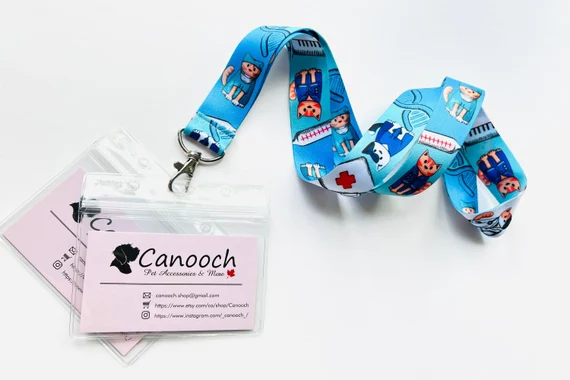
It is widely accepted that lanyards offer so many benefits. They are a cheap, practical, even fashionable accessory that can hold onto a lot of things: from your ID badges and mobile phones to your lanyard key chain. Oh, and they’re great for promoting your brand too!
However, there are still certain risks and dangers associated with the use of lanyards. And it would be worthwhile to explore a few of these.
Strangulation Hazard
The strangulation hazard associated with lanyards arises from the risk of them becoming entangled or caught on objects. This could lead to potentially serious injury among workers or individuals who wear lanyards. This risk is particularly worrisome when lanyards are worn in certain environments or situations.
In industrial environments, for example, with heavy machinery around, lanyards run the risk of getting caught on something. This could cause severe injuries or even strangulation if care is not taken. Workers in such settings should ideally be educated about the risks and provided with safety guidelines.
Entanglement

Lanyards that are not properly worn or managed can pose a risk of entanglement when they become intertwined with nearby objects. This could mean accident or injury suffered by the whoever is wearing the lanyard.
A possible scenario where this might happen is when engaging in outdoor activities like hiking or camping while wearing a lanyard. It becomes a big problem if the lanyard gets caught on branches, rocks and other outdoor elements.
Choking Hazard
Lanyards with attachments like small badges, badges with pins or breakaway components can pose a choking hazard, especially for young children who might put them in their mouths. Young children are naturally curious and often explore objects by putting them in their mouths. This could invariably create a major choking risk for them. Luckily, many schools have adopted policies to limit or avoid the use of lanyards by young children.
Accidental Snagging
Accidental snagging refers to the situation where a lanyard becomes caught, stuck or entangled with objects, surfaces or other items. Lanyards that are not properly managed or worn can pose a risk of accidental snagging, which can occur in various environments and situations. In crowded settings such as events, festivals or public transportation, for example, lanyards can accidentally snag on people, bags, or objects and cause injury or discomfort. This is something to keep in mind when purchasing a lanyard.
Loss of Items
If not securely attached, items like keys or access cards can become detached from the lanyard. While for the most part durable, lanyard attachments – such as a metal clamp or plastic clip – can often break or snap under pressure, causing items to fall off. This can be a source of security or access control issues, or at the very least a big inconvenience.
Restricted Movement
Lanyards can restrict movement or become uncomfortable if worn incorrectly. While lanyards are designed to carry and display items conveniently, improperly wearing them can lead to discomfort, hindered mobility or potential safety concerns. Discomfort in this sense could mean anything from irritation around the neck to restricted blood flow or possible strangulation.
Bear in mind that the length of the lanyard sometimes plays a role in this. A lanyard that is too long or dangles excessively can get caught on objects, leading to unexpected tugging.
Infection Transmission

In healthcare settings, lanyards can potentially carry and transmit infections if not properly cleaned or sanitized. Lanyards in this environment can often come into contact with various objects and surfaces, picking up and transferring pathogens along the way.
Even in seemingly less risky settings where lanyards are shared or exchanged, such as events or conferences, there’s still a risk of cross-contamination if proper hygiene practices are not followed.
How to Manage Risks Caused by Lanyards
The risks with lanyards will always be there as long as they are in such wide use. So, here are a few steps that you can take to mitigate the hazards associated with lanyards.
- Breakaway Lanyards: Use lanyards that are designed with a safety device set to release under pressure. This is sometimes called a breakaway lanyard. This safety break helps reduce the risk of strangulation if your lanyard ever gets caught or pulled.
- Avoid Neck Wearing: Encourage alternative methods of wearing a lanyard. This could range from using retractable badge reels attached to clothing or pockets, to wearing them across the body rather than around the neck.
- Proper Length: Choose lanyards with a manageable length to prevent them from hanging too low or getting caught in objects. If you must wear longer lanyards, pick the ones with a swivel hook. This reduces the chances of them getting tangled up.
- Safety Training: Provide safety training to employees who wear are required to wear a lanyard, especially in industrial or high-risk environments.
- Supervision and Monitoring: In settings involving children, ensure proper supervision and monitoring to prevent them from engaging in activities that could pose a strangulation risk.
- Regulations and Policies: Establish and enforce workplace or school policies that address lanyard safety and outline guidelines for their use.
- Regular Inspection: Regularly inspect your lanyard for signs of wear, damage or deterioration, and replace them if needed.
By being aware of potential hazards and implementing cautionary measures, the safety risk associated with using lanyards can be indeed significantly reduced.
